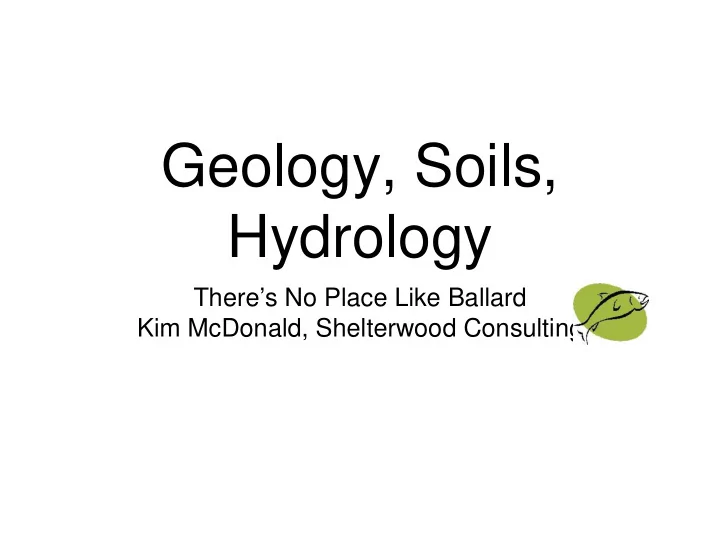

Geology, Soils, Hydrology There’s No Place Like Ballard Kim McDonald, Shelterwood Consulting
Vashon Glacial Till • Formed during Vashon Stade Period • Directly deposited by glacial ice • Undifferentiated clay: finely grained • Commonly referred to as “hardpan” for it’s cement like texture • Exposed examples found on north banks of Discovery Park
Soil Pit
Bore Tests • Hard, gray, SANDY SILT, few gravel; moist. (Difficult drilling) -- Boring B -101
Soil Maps • Dereck Booth, engineering faculty member at U W, complete most recent maps of Seattle. This area of Ballard is primarily built space over Vashon Glacial Till • Sump pumps, wet basements, and water everywhere!
Other Jurisdictions • Vashon Gla lacia ial T l Till ill • Vashon Glacial Till consists of very dense deposits of silty sand to sandy silt, with varying • amounts of gravels. Due to its compact, dense nature, Glacial Till is often referred to as hardpan, • whose soil characteristics limit the movement of ground water through it. Limited amounts of • ground water may be found within the upper three feet of Glacial Till during extended periods of • wet weather. In general, this “perched” ground water will be topographically controlled and will • flow or follow surficial topography towards a point of discharge into a stream or wetland area. • Glacial Till is an excellent bearing soil for foundations of all kinds, but due to its high silt • content is difficult to use and place as structural fill. It is also not considered suitable for • infiltration of stormwater because of its high density and very low infiltration rates at shallow • depths. Recent experience has shown that in many instances stormwater detention ponds located • within Glacial Till need to be lined to limit infiltration into the ponds by perched ground water • during extended periods of wet weather. • SNOHOMISH COUNTY
Soils and Pores • Hydraulic conductivity is a property of soil that describes the “ease” with which water can move through pore spaces. • Generally three types of pore spaces: macro, meso, and micro. • Water movement through soil depends on the permeability of the material (pores, compaction) and degree of saturation.
Infiltration • Process by which water on the ground surface enters the soil. Water enters the ground through pores by force of gravity or capillary action. Larger the pores, the faster the infiltration or movement of water. • Till or clay generally have small pores and saturate (therefore can not infiltrate water at significant rates) quickly.
Test Pit - 119 • Corner of 65th and 28th, one block from Bore Hole 101 • Infiltration rate 0.3 in/per hour. • However, with correction factor of 2 (correction factors apply to determine long term infiltration rates) 0.3 ÷ 2 = .15 in/hr • 40 hours for 6” of water.
Vegetation • Vegetation help create pores in soils. • Also help by transpiring water. • Not that effective in “moving water” unless growing season
Water? • Evapotranspiration and infiltration • For hydrologists there is no such thing as 20, 25, 30, 100 year storms. Nature, sometimes, is hard to model. Plan for the worst is a good thing, but it when it rains it pours • And what about climate change? Native plants may not adapt, increase frequency of rain events in the PNW
Why Ponding? • Water infiltrating through sand enhanced soil (bioretention soils). Water then encounters till layer, already saturated by mid-October. Water can not “perc” through saturated clay.
Solutions? • Lessons learned? Can not engineer around nature. “Local knowledges” are key. • Pay attention to Best Management Practices (infiltration rates in particular) • Some possible detention systems throughout CSO 152 which can collect water • Large scale encouragement of Rainwise programs
We All Care About Our Sound
Recommend
More recommend